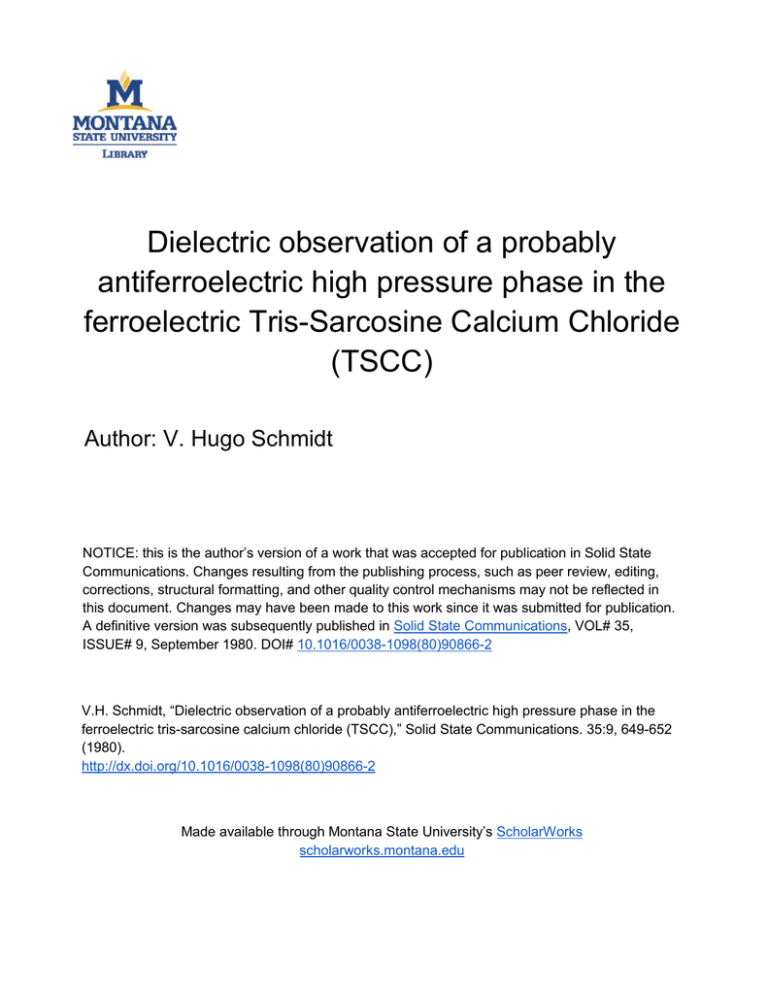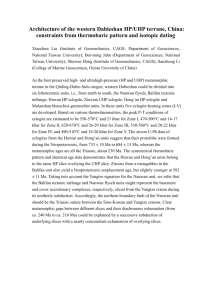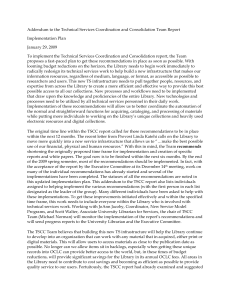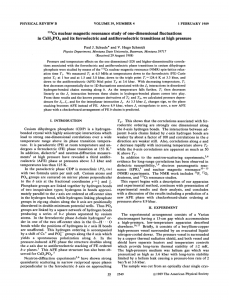Dielectric observation of a probably antiferroelectric high pressure phase in the
advertisement

Dielectric observation of a probably antiferroelectric high pressure phase in the ferroelectric Tris-Sarcosine Calcium Chloride (TSCC) Author: V. Hugo Schmidt NOTICE: this is the author’s version of a work that was accepted for publication in Solid State Communications. Changes resulting from the publishing process, such as peer review, editing, corrections, structural formatting, and other quality control mechanisms may not be reflected in this document. Changes may have been made to this work since it was submitted for publication. A definitive version was subsequently published in Solid State Communications, VOL# 35, ISSUE# 9, September 1980. DOI# 10.1016/0038-1098(80)90866-2 V.H. Schmidt, “Dielectric observation of a probably antiferroelectric high pressure phase in the ferroelectric tris-sarcosine calcium chloride (TSCC),” Solid State Communications. 35:9, 649-652 (1980). http://dx.doi.org/10.1016/0038-1098(80)90866-2 Made available through Montana State University’s ScholarWorks scholarworks.montana.edu 0) Solid State Communications, Vol.35, pp.649—652. Pergainon Press Ltd. 1980. Printed in Great Britain. DIELECTRIC OBSERVATION OF A PROBABLY ANTIFERROELECTRIC HIGH PRESSURE PHASE IN THE FERROELECTRIC TRIS-SARCOSINE CALCIUM CHLORIDE (TSCC) V. Hugo Schmidt Laboratoire de Spectrométrie Physique (associd au C. N. R. S.), Universitd Scientifique et Mddicale de Grenoble, Boite postale no 53, 38041 Grenoble Cedex, France (on sabbatical leave from Montana State University, Bozeman, MT 59717, U.S.A.) (Received 20 May 1980 by E. F. Bertaut) Dielectric susceptibility and ferroelectric hysteresis measurements on TSCC show that the 2nd-order paraelectric-ferroelectric (PE-FE) phase boundary beginning at (130.8 K, 1 bar) runs with pronounced curvature to (176.8 K, 5.03 kbar), where a new phase of low dielectric susceptibility appears. This phase is hypothesized to be antiferroelectric (AFE) with 3 possible structures: orthorhombic 1P2 12121, piezoelectric) or rnonoclinic (P21/a or P21/n, centrosymmetric) . The FE-AFE phase boundary was determined down to (81.0 K, 2.60 kbar) and the PE-AFE boundary up to (225.5 K, 6.82 kbar). Both the FE-AFE and PE-AFE transitions are of let order over the range studied. Tris—sarcosine calcium chloride (TSCC) is a -Ferroelectric with several unusual properties. It grows from aqueous solution in the paraelectric (PE~ phase with a structure which is orthorhombic (D~ - Pnma) but so nearly hexagonal that the crystal is ferroelastic; uniaxial stress along c near 200°Ccan in effect rotate the2structure about the pseudo-hexagonal a axis The structure i~the PE phase has 4 formule units of (CH3NH2 CH2COO )3 CaC12 per unit cell, with the Ca ++ ions and 4 of the 12 sarcosine dipoles in (probably disordered) positions corresponding to the mirror plane perpendicular to b. Below the ferroelectric (FE) transition temperature T~this mirror plane must vanish because b becomes the FE axis; it has been assumed that ~he 2la~Z structure 4. of No the FE superstructure was foun~ phase is orthorhombic C h~in re~ent X-ray diffraction studies of the FE phase . consistent with 7 remaining 4 in that phase. The Curie-Weiss coistant C 3a~dspontaneous paramapolarization P5 are quite6 and smallelectron ‘ . Nuclear gnetic magneticresonance resonance(EPR)7’8 (NMR) results have been interpreted in terms of an order-disorder ~r~ 8sition, but recent Raman scattering results revealed a soft mode below Tc which mdi— cates that the transition is at least partly displacive. The pressure dependence of T has 12. The initial reported12 disapan unusually large positive slope and pearance the dielectric anomaly above 4 kbar negative of curvature~’ was the motivation for the present search for a third phase of TSCC at high pressure. The crystals used in these measurements were recrystallized by evaporation of an aqueous solution of TSCC crystals grown from 98% pure sarcosine and reagent gr~deCaCl .2H 0. Absence of ferroelastic twins and op~ica~ly observable defects was verified by means of a polarizing microscope. The crystals were pollshed on wet filter paper into plates whose faces perpendicular to the FE b axis were covered with evaporated gold electrodes. The first crystal is 1.4 mm thi~kalong b with electroded faces of area 18.3 mm , while the ~econd has thickness 2.95 mm and area 37.8 mm Contacts to these electrodes were provided by weakly spring-loaded brass pistons inside the sample holder, which in turn was placed inside a stainless steel pressure cell having two 4-wire electrical inputs. The cell was pressurized with helium by means of a compressor and intensifier which could attain 6 kbar. For later experiments with the second crystal, another intensifier provided nearly 7 kbar before leaks from connections became excessive. sure measurement to 1% accuracy.permitted The crystals A manganin cell and transducer preswere cooled at rates as slow as -0.2 K/mm by sending pulses of liquid nitrogen each minute through passages provided in the cell, which was thermally insulated only by a layer of yed in some Shorter warming nitrogen runs while in others the styrofoam. pulses were emplonatural warming rate of about 0.5 K/mm was used. Sample temperature was determined within +1 K by measuring with the 4-terminal method the resistance R(p) of a platinum resistor at pressure p inside the cell near the crystal. then applying the approximate correction formuallow T vs.p) R(0) and kbar finally la R(0)use= of (1 +the 0.002 R(p) tables, with p in to correcting for the thermal lag (2 to 5 mm., increasing with TJ of the crystal as found from comparing dielectric results for warming and cooling runs. The small-signal dielectric susceptibility of both crystals was measured with a Wayne-Kerr 6221 “magic eye” bridge operating at 3 V rms and angular frequency w = 2~f= 1D4/sec, with sensitivity 0.01 pf and 10 micromho. Provi649 650 FERROELECTRIC TRIS—SARCOSINE CALCIUM CHLORIDE (TSCC) sion for dc bias fields up to ±2000V/cm was added for some of the later measurements on the first crystal. Chart recorder traces of Vol. 35, No. 9 best -Fits to the expression 2 to hysteresis loops were obtained for the first crystal, using a 0.05 Hz source supplying peak fields up to 2000 V/cm. Both the susceptibility and hysteresis measurements were made at intervals ranging from 1 minute near the transitions to 5 minutes farther from the transition. The primary result of these experiments is the discovery of a third, probably antiferroelectric CAFE), phase of TSCC which exists only at high pressure as shown in Fig. 1. This work also supplements previous studies of dielectric properties at ambient pressure and of the pressure dependence of the paraelectric-ferro11 12 electric (FE-FE) transition temperature T~ ‘ + t 1p + t2p (1] were made for the transition temperatures T(p) for each of the three phase boundaries. These three parabolas come within 0.01 kbar and 0.1 K of intersecting at a single point located at Pt = 5.03 kbar, T~ = 175.3 K, which was then imposed as the common point for each transition in the expression Tt + T 2 T 1(p + T21p (2) - The best-fit parameters T and T were then found for the FE-FE and F~-AFE t~ansitions. Finally, this best-fit I for the FE-AFE line . 24C I 2~- PE T,K 160 - - FE 120 SCl 0 AFE? I I 2 V.kbar - I 4 6 Figure 1 Phase diagram for tris-sarcosine calcium chloride (TSOC), showing the paraelectric [FE). the ferroelectric (FE), CAFE) and the probably anti-Ferroelectric high-pressure phase. The FE-FE transition is probably 2nd order. while the PE-AFE and FE—AFE transitions are 1st order. Some closely adjacent experimental points have been combined for clarity. Open and filled circles represent data from the let and 2nd crystal respectively. while half-filled circles represent data from both crystals. The FE-FE phase boundary was determined by the temperature at which the inverse susceptibility ft vanishes on linear fits using a 20°C interval above Tc~ or by the onset of hysterssis. The PE-AFE boundary was marked by a sudden change in C, while the FE-AFE boundary was located by such change or by the sudden dieappearance of hysteresis loops, Mathematical expressions for the phase boundaries were determined as follows. Because results from the first crystal were the most extensive for the FE-FE and FE-AFt boundaries, they were used to determine the PE-FE—AFE common point and then the PE-FE and FE-AFE boundary expressions. First. separate 3-parameter was imposed also as the initial slope T1 for the P5-AFt line, and the best-fit T2 was then found for that line using data from both crystals. This common-slope assumption is required if the PE-FE transition is 2nd-order and the FE-AFE and FE-AFE transitions are first-order, as indicated by the dielectric results. A pos-ET1 w517 190 m542 190 lSB tenon justification for this assumption and the parabolic form for Eq. (2) is that this 7-parameter fit to all the data cannot be substantially improved by introducing additinnal parameters. The best-fit parameters found by the above procedure appear in Table I, together with pararneters found prsviously’~ for the FE-FE transition. FERROELECTRIC TRIS—SARCOSINE CALCIUM CHLORIDE (TSCC) Vol. 35, No. 9 Table I. Coefficients t 1 and T. in EqS. (1) and (2) for pressure dependences o~phase transition temperatures in TSCC, including coefficients found previously (Ref. 11) over the 0 to 2.1 kbar pressure range t Transition , 0 K PE-FE~ 128 6+0 2 FE-FE 130:8+0:4 - t , 1 K/kbar T , 1 K/kbar 13 2+0 4 -0 5+0 2 14:5+0:3 3.82+0.2 1:06+O.04 - FE-APE T2(=t2) 2 K/kbar ‘ - ‘ 29.2~0.5 -4.16 ~Ref. 11 The t (ambient-pressure T ) values differ as is typical for two crystals ~rom different res t also somewhat outside experimentsources, and differ the . initial slopes t and curvatu-. 2 . al error. The initial slope T~of 14.5 K/kbar is unusually large, but what is more striking is the strong curvature which reduces the slope to 3.82 K/Fcbar at the common point, and which would give a maximum T of 180.2 K at only 6.83 kbar if the AFE phase did not intervene. qualitativaly similar Slope and 1~urvaturewere found by Hegenbarth and Schmidt , but they noted disappearance of the dielectric anomaly at only 4 kbar. The FE-APE boundary extrapolates to 1.14 kbar at 0 K, So the AFE phase can be presumed to exist only at high pressure. The curvature is greater than that of the PE-AFE boundary because of the progressively lower free energy of the FE phase compared to the FE phase as one moves down along the FE-AFE boundary. The dielectric susceptibility results, within the limitations imposed by the rapid rate of temperature change and relatively high -Frequencies used, indicate a 2nd-~rgerPt-FE transition as reported previously ‘ . Straight Curie-Weiss plots of (C - 6)1 vs. T were ohtamed for the first 20°above T at all pressures, including 5.6 kbar where ~he CurieWeiss behavior is interrupted by the appearance of the AFE phase. The Curie-Weiss constant C in c C/(T - T ) was 31 + 2 K with no noticeable pressure de~endencefor the first crystal, and 30 + 4 K at 4.18 kbar for the second crystal. These values are wi~h~n6the wide range 17 to 58 found by others ‘ ‘ . The peak dielectric constant at Tc for the first crystal was in the 300 to 500 range.1~ncreasing with pressure as noted previously . This increase can be explained in terms of a defect-indu~dspread in local pressure inside the crystal , which gives correspondingly smaller transition temperature spreads ATc as pressure increases because of the decreasing dT /dp. The crystal, acting as a series-paralle~combination of tiny crystals each with its own Tc~then has higher peak C as decreases. The second crystal had peak C of over 1000 at 4.16 kbar. Below T the Curie-Weiss constants were near 200 for the first crystal and 80 for the second, and the loss tan 6 was quite large. Both effects probably resulted from domain wall motion at the relatively large field (3 V/cm) and low frequency (1592 Hz) used. The loss de- 651 creases with decreasing temperature below T0. Application of dc bias reduced both the dielectric susceptibility and loss as expected, but within the limited thermal accuracy had no effect on any transition temperatures. The PE-AFE and FE-AFE transitions appear to be of first order, because there are no anomalies in the PE or FE behavior until the onset of the AFE phase, which has a small dielectric susceptibility without noticeable temperature or pressure dependence. hysteresis loops,thin studied only for just the first The crystal, were very and S-shaped below T . With decreasing T they became wider and rou~dedat the tips, indicating that even 2000 V/cm was insufficient field for saturation. At still lower temperature the loops again became narrower and regained their pointed tips. 2 and the coerAt I bar pressure the spontaneous polaricive at 0.05 Hz and E zationfield was near 300 0.11 V/cm, microcoul/cm peak of 900 V/cm. Both values are ~maller than reported by Sorge and Straube No double hysteresis loops were seen in the APE phase, in accord with the assumed firstorder nature of the FE-AFE transition. The new phase probably exhibits ordering of the structural elements that are in highsymmetry positions in the FE phase. There are 4 such elements in the FE unit cell each consisting of a calcium ion and sarcosine dipolar molecule lying in a mirror plane perpendicular to b. These can order pairwise in 4 ways as shown in Table II. Table II. Possible structures of TSCC phases. The Dipolar Arrangement (Dip. Arr.) column shows the signs of the b-axis components of the dipole moments associated with the 4 sarcosine molecules (AB CD) which in the FE phase lie in mirror planes perpendicular to b. Molecules A and B lie in one such plane, while C and 0 lie in another. Molecules B and C are connected by a one-dimensional network of N-H.. .Cl hydrogen bonds running along b as shown in Ref. 1. while A and 0 lie in two other such networks. Phase PE FE APE AFE APE Dip. Arr. Structure Nature Status 00 00 orth. Pnma centrosym. meas. ++ ~+ orth. Pn21a ferroel. probable +— -+ orth. P212121 piezoel. possible 4- 4mono. P21/n centrosym. poss. ++ -mono. P21/a centrosym. p055. 3 One order type was proposed by Makita as the FE structure. In the other 3 structures the dipole moments of the ordered elements cancel, and each structure permits 2 domain types, so these structures are all AFE. These 3 possible space groups can be distinguished in principle by X-ray or neutron diffraction studies, both of which are planned. Knowledge of the order type would aid in determining which short range dipolar interactions are most important. The above APE structure hypotheses require a 1st-order FE-APE transition in accord with the present findings but do not restrict the other transitions. The PE-AFE transition was also found to be 1st-order, but could exhibit a tricritical point at higher pressure. The 652 FERROELECTRIC TRIS—SARCOSINE CALCIUM CHLORIDE (TSCC) FE-FE transition which is 2nd-order at 1 bar 5 appears to remain 2nd order over its whole pressure range, but more accurate measurements Vol. 35, No. 9 cularly to 3. E3eille and .1. Voiron for the use are needed for certainty, Acknowledgement- Thanks are expressed to personnel of the Laboratoire Louis Néel, C.N.R.S. for their cooperation in this experiment. parti— of their high pressure apparatus and to S. Pelosi for technical assistance. Also apprecia— ted are helpful discussions with 3. LajzArowicz_ Elonneteau, 3. LajzArowicz and F. Vallade. aid ~-F F. Bastie with numerical calculations, arid technical assistance by P. Falleau. References 1. 1. Ashida, S. Bando and F. Kakudo, Acta Cryst. B28, 1560 (1972). 2. A. Sawada, Y. Makita and Y. Takagi. 3. Phys. Soc. Jap. 42, 1918 (1977). 3. Y. Makita, 3. Phys. Soc. Japan 20, 2073 (1955). 4. 3. Lajzérowicz-Elonneteau, private communication. 5. 9. Sorge and U. Straube. Phys. Stat. 501. (a) 51. 117 (1979). 8. A. Levstik, C. Filipi~ and R. Blinc, Solid State Commun. 15, 1231 (1975). 7. R. Lippe, W. Windsch, 5. VOlkel and W. Schulga, Solid State Commun. 19, 587 (1976). 8. W. Windsch and 0. VBlKel. Ferroelectrics, 24, 195 (1980). 2. 5. 0. Prokhorova. 5. A. SmolenoKy, I. S. Siny. F. 5. Kuzminov. V. D. Mikvabya and H. Arndt, 25. 529 (1930). 10. 2. 6. Feldksmp, K. Douglas. El. El. Lavrencic and 3. F. Scott, Bull. Am. Phys. Soc. 25, 171 (1980). i~. vi. Windsch and V. H. Schmidt, Hull. Am. Phye. Soc. 24, 507 (1979). and to appcar in Ferroelectrics 30. 12. E. Hngnnbarth and B. Schmidt, Ferron)ectrics 25. 369 (1980). 13. ]~HasSle, th2se d’Etat, Srenoble 119811].






